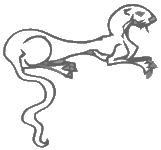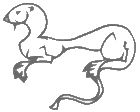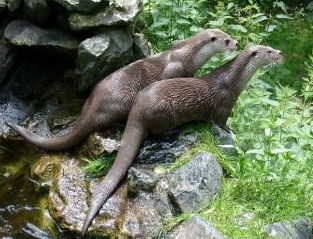 |
 |
 |
 |
 |
 |
 |
 |



Eurasian Otter
Size: From nose to tail,
the Eurasian otter is 102 to 137 cm long. The tail alone
is 35 to 40 cm, long. Females are substantially smaller than
males. Feet: Partially webbed,
with strong claws. Track/Sign: Eurasian otters regularly leave spraints to mark their territories or let other otters know where they are hunting. Spraints are often 6 to 8 cm long, dark colored, and have a lot of small fish bones. Spraints generally smell musky or fishy. Other signs of otters in the area include partially eaten fish and tracks.
Ecology Habitat: Eurasian otters are found almost everywhere that there is water near, fresh or salt, as long as there are freshwater pools nearby for drinking and bathing. An average male Eurasian otter's territory is about 15 mi
of river. This is highly variable with productivity of the
body of water---territory can range between 7.5 and 50 miles
of waterfront (the lower end tends to be those living on the
coast where food is more abundant). Females' territories tend
to be less than half the size of the males', and often overlap
with them. Range/Distribution: Throughout Asia, Africa, and Europe.
Conservation
Status: Near threatened
Behavior Life Cycle: Eurasian otters reproduce at different times depending on where they live. In many areas, they reproduce throughout the year, but in areas with harsh climates or seasonally changing food availability, there is greater preference for certain times of the year. Gestation lasts for about 63 days. There will be two or three pups in each litter, each weighing about 40g. The pups nurse for two or three months. Their eyes will open in five weeks, and at seven weeks they start to eat solid food. Pups leave the holt for the first time at ten weeks, and are weaned at 14 weeks. The mother will start teaching the pups to swim at at about 16 weeks. They start catching fish at about 8 months, but are still dependent on their mother providing most of the food. Cubs will stay with their mother until 14 or 15 months, at which point they will leave to find territory of their own. They reach full maturity at two years of age. Eurasian otters tend to live alone except when mating, when the male and female may stay close together for about a week, or for females, when raising a litter. Social: Eurasian Otters are more solitary than most other otter species. Males and females do not exhibit strong pair bonds. Otters communicate using vocal expression such as whistles, birdlike twittering and spitting. They can also communicate using spraint. Over 100 different scent components of otter dropping have been identified. About 17 of these are thought to contain information on sex, age and even individual recognition, which can be used by other otters. active dawn and dusk or night. Individual: Eurasian otters tend to be nocturnal.
These otters are often trained by fishermen to drive fish into their nets.
Spanish: Nutria, Nutria comun
Subspecies:
|
OtterQuest (c) 1999-current. Contact OtterQuest.
A few images on this web site have been borrowed from other sources, I credit them in the Links/Resource Page. Some may not yet be credited, if you know the source of an uncrdited photograph, please e-mail me with the information. Thank you. Dana


 Identification
Identification


